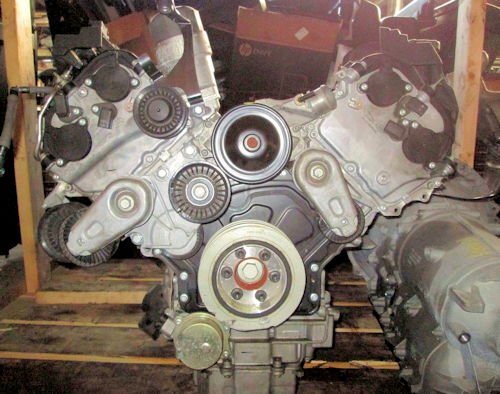Jaguar AJ126 3.0-liter V6 engine

The AJ126 is basically based on the Jaguar AJ133 V8. Due to the external similarity of the housing and cylinder heads both engines, d. H. Both the V6 and the V8 are manufactured on a production line, since only minor changes to the tools and processes are necessary. A relationship with engines from the house Ford does not exist. The AJ126 in the JLR Group replaces the previously used AJ-V6 with 60 ° cylinder angle.
The AJ126 has 2,995 cc capacity with a bore of 84.5 mm and a stroke of 89 mm. The cylinder angle is 90 °. The compression is 10.5: 1. All versions of the AJ126 are supercharged and differ in detail, especially in terms of performance.
The AJ126 is a 3.0 L (2,995 cc (182.8 cu in)) 90° petrol V6, having a bore of 84.5 mm (3.3 in) and stroke of 89 mm (3.5 in) with a 10.5:1 compression ratio. It is supercharged and liquid cooled featuring direct fuel injection, four overhead camshafts and four valves per cylinder. There are two versions differing in power produced, a standard version making 340 hp (254 kW; 345 PS) at 6500 RPM and 332 lb⋅ft (450 N⋅m) between 3500-5000 RPM and a high-performance variant making 380 hp (283 kW; 385 PS) at 6500 RPM and 339 lb⋅ft (460 N⋅m) between 3500-5000 RPM.
The main structural components of the engine are all manufactured from aluminum alloy. The engine is built around a very stiff, lightweight, enclosed V, deep skirt cylinder block. A structural windage tray is bolted to the bottom of the cylinder block to further improve the block stiffness, minimize NVH (noise, vibration and harshness) and help reduce oil foaming. To further enhance the stiffness of the lower engine structure, a heavily ribbed sump body is installed. The sump body also helps to reduce engine noise.
The engine uses a Bosch high pressure direct injection fuel system with fuel pressure provided by two, cam driven high pressure pumps which are driven by a dedicated camshaft. The high pressure pumps supply the fuel rails which in turn supply the three injectors for that bank with fuel at a controlled pressure.
The four camshafts incorporate VCT (variable camshaft timing). VCT allows the timing of the intake and exhaust valves to be adjusted independently of each other. The VCT system is controlled by the Bosch ECM (engine control module) using information from CMP (camshaft position) sensors.
The supercharger is located in the 'vee' of the engine and is driven from the crankshaft by a dedicated secondary drive belt.
The engine meets EU5 emission regulations in Europe and Rest of World (ROW) and ULEV 70 emission regulations in North American Specification (NAS) markets.
The direct fuel injection system, advanced piston and combustion chamber design and the supercharger provide improved fuel consumption and emissions.
The AJ126 V6 is basically an AJ133 V8 engine that has 2 fewer cylinders and is made on the same production line as the AJ133. It shares a very similar block as the supercharged V8 AJ133, with some differences such as reduced bore size. Cylinder heads are also derived from the V8 engine. The engine features a balance shaft to drive the oil pump and balance the crankshaft. Vehicles use this engine:
2012– Jaguar F-Type V6
2015– Jaguar XE V6
2014– Range Rover Sport (L494)
2012– Range Rover (L405)
Overview of AJ126 Engine and Series
| engine | Displacement | Period | kW | PS | nm | feature | vehicles |
|---|---|---|---|---|---|---|---|
| AJ126 | 3.0 | from 06/2013, 06 / 2015-05 / 2017, from 09/2015 | 250 | 340 | 450 | 1.75 bar boost pressure | Jaguar F-Type, XE S, XF 35t |
| AJ126 | 3.0 | from 06/2013, from 05/2017, from 09/2015 | 280 | 380 | 460 | 1.9 bar boost pressure | Jaguar F-Type S, XE S, XF S |
| AJ126 | 3.0 | from 01/2017 | 294 | 400 | 460 | Jaguar F-Type 400 |


